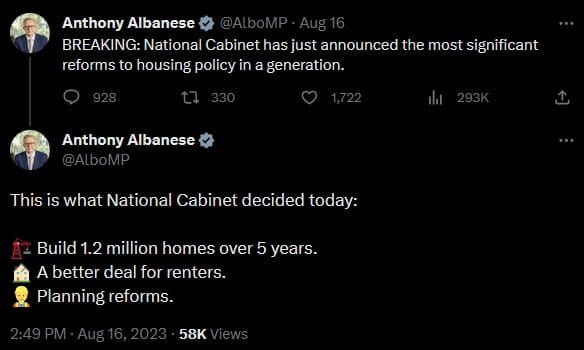The cooler heads prevailed
National Cabinet – where Australia’s States and federal government get together to try to agree on national policy – reached an agreement this week to:

Here’s a link to the full policy reveal, which explains that the 1.2 million target is really just an increase of 200,000 over the existing target. Not bad, but how are governments going to achieve that target? Why with more money, of course:
“The Commonwealth has committed to $3 billion for performance-based funding, the New Home Bonus, for states and territories that achieve more than their share of the one million well-located home target under the National Housing Accord. This will incentivise states and territories to undertake the reforms necessary to boost housing supply and increase housing affordability, making a positive and practical difference for Australians planning to buy a home.
This ambitious target will be supported by the Housing Support Program, a $500 million competitive funding program for local and state governments to kick-start housing supply in well-located areas through targeted activation payments for things like connecting essential services, amenities to support new housing development, or building planning capability.”
Australia’s population is currently 26,268,359. Treasury is forecasting an annual increase of 1.3-1.4% over the next five years, or around 365,000 annually. At 2.5 people per household, that would mean we need about 730,000 new dwellings just to break even – and many more than that to reduce prices. The RBA estimates that a 1% increase in houses constructed per capita lowers the cost of housing by 2.5%, so if the full 1.2 million target was hit that would increase the housing stock by around 1.7% per capita, reducing prices and rents by just over 4%.
So in terms of the target, it’s a good start but won’t do all that much on its own. I’m also not so sure that the $15,000 state governments will get for every one of the extra 200,000 homes they deliver is enough to offset the incentives state and especially local government officials face to appease NIMBYs (especially as payments won’t even happen until 2028, well beyond the campaign life cycle of today’s politicians), although it’s certainly better than nothing.
But perhaps the best outcome from the meeting was that the cooler heads prevailed and no one agreed that freezing rents would be a good idea:
“What we know, though, is that the idea that you just have a rent freeze, there is no jurisdiction in the country that is arguing for that, including the ACT Government, which has been spoken about. No one is arguing that that will make a positive difference. Indeed, we believe that will make it worse. The key to addressing these issues is supply and that’s why we have focused our attention on supply.”
There was also an acknowledgement that the best way to improve housing affordability is through reform, with the following points included as part of ‘Attachment 1’:
- “Updating state, regional and local strategic plans to reflect their share of housing supply targets.
- Undertaking planning, zoning, land release and other reforms, such as increasing density, to meet their share of housing supply targets.
- Streamlining approval pathways, including strengthened ‘call in powers’, and prioritising planning amendments to support diverse housing across a range of areas e.g. by addressing barriers to subdivision for appropriate medium density housing.
- Promoting medium and high-density housing in well located areas close to existing public transport connections, amenities and employment.”
All good ideas. But it’s all just talk – will any substantial housing reform actually materialise, or will the vested interests firmly embedded in Australia’s political apparatus frustrate even the most dedicated reformist into giving up, as has happened over the past several decades?
